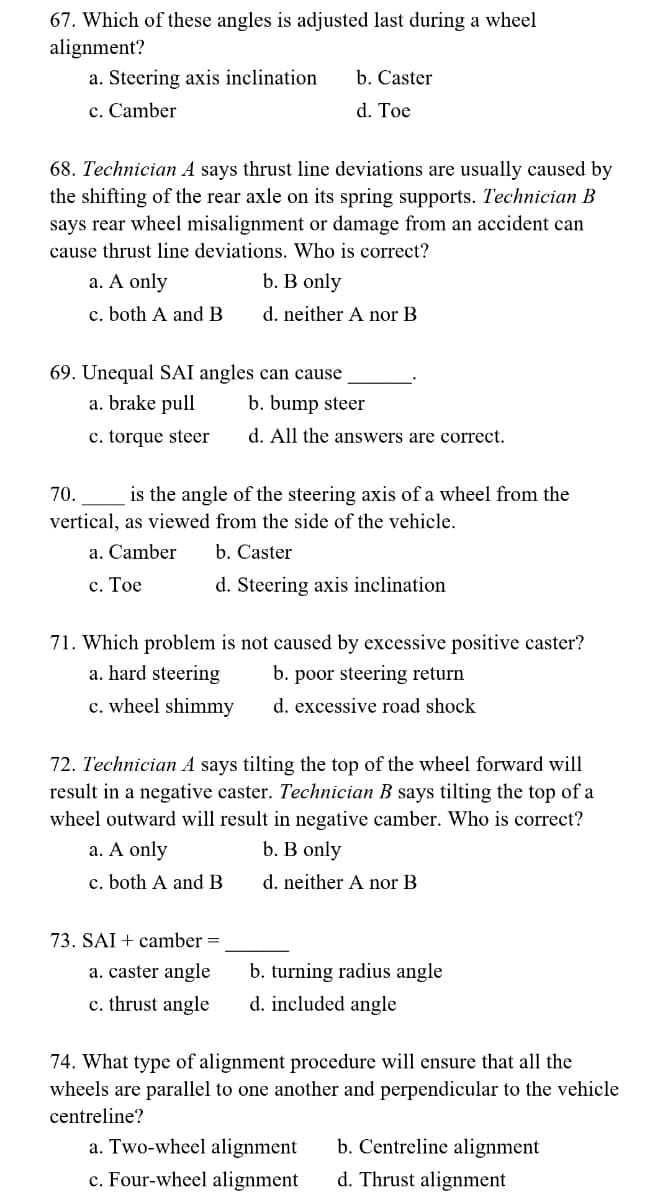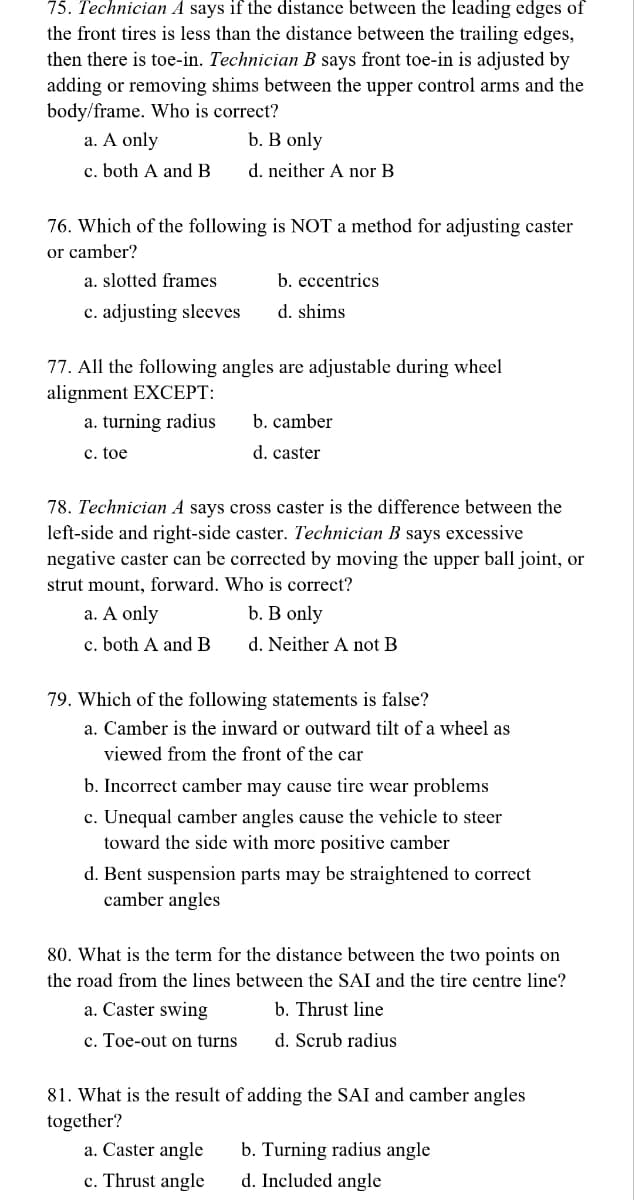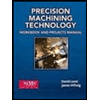67. Which of these angles is adjusted last during a wheel alignment? a. Steering axis inclination c. Camber b. Caster d. Toe
67. Which of these angles is adjusted last during a wheel alignment? a. Steering axis inclination c. Camber b. Caster d. Toe
Automotive Technology: A Systems Approach (MindTap Course List)
6th Edition
ISBN:9781133612315
Author:Jack Erjavec, Rob Thompson
Publisher:Jack Erjavec, Rob Thompson
Chapter45: Tires And Wheels
Section: Chapter Questions
Problem 14RQ: All of these statements about improper wheel balance are true except? a. Dynamic imbalance may cause...
Related questions
Question
Hello, I am trying to study for a test and found this practice review but I'd like to be able to check my work. Can someone help answer some of these questions? Thank you

Transcribed Image Text:67. Which of these angles is adjusted last during a wheel
alignment?
a. Steering axis inclination
c. Camber
68. Technician A says thrust line deviations are usually caused by
the shifting of the rear axle on its spring supports. Technician B
says rear wheel misalignment or damage from an accident can
cause thrust line deviations. Who is correct?
b. B only
d. neither A nor B
a. A only
c. both A and B
69. Unequal SAI angles can cause
a. brake pull
c. torque steer
b. Caster
d. Toe
b. bump steer
d. All the answers are correct.
70.
is the angle of the steering axis of a wheel from the
vertical, as viewed from the side of the vehicle.
a. Camber
c. Toe
b. Caster
d. Steering axis inclination
71. Which problem is not caused by excessive positive caster?
a. hard steering
b. poor steering return
c. wheel shimmy
d. excessive road shock
73. SAI + camber =
a. caster angle
c. thrust angle
72. Technician A says tilting the top of the wheel forward will
result in a negative caster. Technician B says tilting the top of a
wheel outward will result in negative camber. Who is correct?
b. B only
a. A only
c. both A and B
d. neither A nor B
b. turning radius angle
d. included angle
74. What type of alignment procedure will ensure that all the
wheels are parallel to one another and perpendicular to the vehicle
centreline?
a. Two-wheel alignment
b. Centreline alignment
c. Four-wheel alignment d. Thrust alignment

Transcribed Image Text:75. Technician A says if the distance between the leading edges of
the front tires is less than the distance between the trailing edges,
then there is toe-in. Technician B says front toe-in is adjusted by
adding or removing shims between the upper control arms and the
body/frame. Who is correct?
a. A only
b. B only
c. both A and B
d. neither A nor B
76. Which of the following is NOT a method for adjusting caster
or camber?
a. slotted frames
c. adjusting sleeves
b. eccentrics
d. shims
77. All the following angles are adjustable during wheel
alignment EXCEPT:
a. turning radius
c. toe
b. camber
d. caster
78. Technician A says cross caster is the difference between the
left-side and right-side caster. Technician B says excessive
negative caster can be corrected by moving the upper ball joint, or
strut mount, forward. Who is correct?
a. A only
b. B only
c. both A and B
d. Neither A not B
79. Which of the following statements is false?
a. Camber is the inward or outward tilt of a wheel as
viewed from the front of the car
b. Incorrect camber may cause tire wear problems
c. Unequal camber angles cause the vehicle to steer
toward the side with more positive camber
d. Bent suspension parts may be straightened
camber angles
80. What is the term for the distance between the two points on
the road from the lines between the SAI and the tire centre line?
a. Caster swing
b. Thrust line
c. Toe-out on turns
d. Scrub radius
81. What is the result of adding the SAI and camber angles
together?
a. Caster angle
c. Thrust angle
b. Turning radius angle
d. Included angle
Expert Solution
This question has been solved!
Explore an expertly crafted, step-by-step solution for a thorough understanding of key concepts.
This is a popular solution!
Trending now
This is a popular solution!
Step by step
Solved in 3 steps

Knowledge Booster
Learn more about
Need a deep-dive on the concept behind this application? Look no further. Learn more about this topic, mechanical-engineering and related others by exploring similar questions and additional content below.Recommended textbooks for you

Automotive Technology: A Systems Approach (MindTa…
Mechanical Engineering
ISBN:
9781133612315
Author:
Jack Erjavec, Rob Thompson
Publisher:
Cengage Learning

Precision Machining Technology (MindTap Course Li…
Mechanical Engineering
ISBN:
9781285444543
Author:
Peter J. Hoffman, Eric S. Hopewell, Brian Janes
Publisher:
Cengage Learning

Automotive Technology: A Systems Approach (MindTa…
Mechanical Engineering
ISBN:
9781133612315
Author:
Jack Erjavec, Rob Thompson
Publisher:
Cengage Learning

Precision Machining Technology (MindTap Course Li…
Mechanical Engineering
ISBN:
9781285444543
Author:
Peter J. Hoffman, Eric S. Hopewell, Brian Janes
Publisher:
Cengage Learning